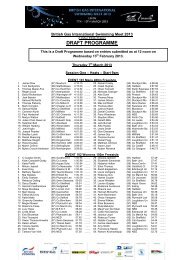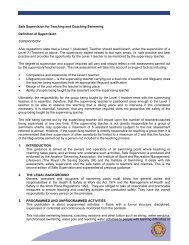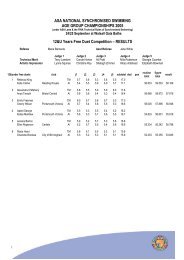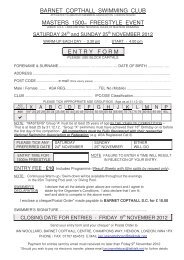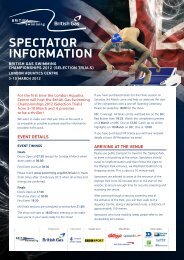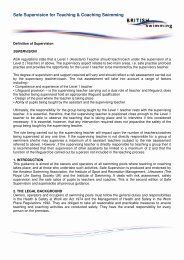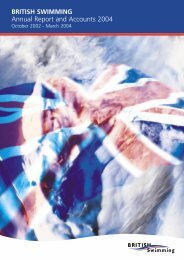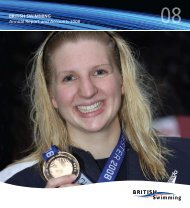Inclusion of Swimmers with a Disability - Swimming.Org
Inclusion of Swimmers with a Disability - Swimming.Org
Inclusion of Swimmers with a Disability - Swimming.Org
Create successful ePaper yourself
Turn your PDF publications into a flip-book with our unique Google optimized e-Paper software.
<strong>Swimming</strong> stages<br />
<strong>Swimmers</strong> <strong>with</strong> a disability require<br />
the same opportunities as their peers<br />
to become familiar <strong>with</strong> the water<br />
environment and to progress <strong>with</strong><br />
swimming skills. Extra time, support<br />
and skill adaptations may be needed.<br />
The teaching principles and practises<br />
used are the same for all swimmers<br />
<strong>with</strong> the techniques adapted to suit<br />
the individual. The important factor<br />
is that rarely are two people identical<br />
and the teacher must consider how<br />
the individual’s physique, mobility<br />
and application affects the swimming<br />
technique.<br />
Breathing skills are very important.<br />
People who have difficulties swallowing<br />
may be at risk and require careful<br />
observation<br />
First steps<br />
The first steps are usually the biggest.<br />
Specialist swimming aids are rarely<br />
required - the purpose being to ensure<br />
safety in as positive a swimming position<br />
as possible, taking into consideration<br />
individual preferences.<br />
Listed below is a variety <strong>of</strong> equipment<br />
that has been found to be useful.<br />
Teachers have differing views on<br />
swimming aids, as do individual<br />
swimmers. Aids can be used to obtain<br />
a safer, streamlined position, they are<br />
not for life saving.<br />
Arm bands/arm rings<br />
l Develop early confidence and<br />
independence.<br />
l Buoyancy can be reduced as<br />
confidence grows.<br />
l Lessons become active.<br />
l They are non restrictive.<br />
Buoyancy suits<br />
l All <strong>of</strong> the above, plus they encourage<br />
a more streamline body position.<br />
Head floats (specialist aids in certain<br />
circumstances)<br />
l Help support head above water line,<br />
but some can restrict streamlining.<br />
Rings<br />
l Short term use for swimmers who<br />
learn propulsion in an upright<br />
position.<br />
Floats/woggles (opposite)<br />
l Encourage a horizontal position.<br />
l Allow early kicking skills to develop.<br />
l Allow concentration on specific<br />
actions.<br />
l Can be adapted to suit very small<br />
hands.<br />
Variety <strong>of</strong> balls<br />
l Encourage confidence in water.<br />
l Can give different amounts <strong>of</strong><br />
buoyancy.<br />
Egg flips (opposite)<br />
l Encourage breathing through the<br />
mouth at surface <strong>of</strong> water.<br />
Toys (opposite)<br />
l Encourage water confidence<br />
(watering cans, squirters).<br />
l Can be used for games.<br />
l Pushing, pulling.<br />
l Can be used as objects to chase.<br />
Sinking objects, eg bricks, hoops,<br />
novelties (opposite)<br />
l Encourage submerging and opening<br />
the eyes under water.<br />
l Can be used to develop other skills<br />
e.g. colours, counting.<br />
Head float<br />
Buoyancy suit<br />
Ring/arm bands<br />
7



